SIMIT made significant progress in artificial synapse
Date:20-06-2019 | 【Print】 【close】
Separation structure of data processing and storage separation in traditional Von Neumann architecture based digital computers on limits its working efficiency and brings huge power consumption. This makes traditional based digital computers can’t meet the computational complexity of the big data era and hinder the further development of deep learning neural networks. Imitating synaptic structure of human brain and the construction of a simple structure, low power consumption, high and low resistance state continuously adjustable non-volatile resistive memristor is a crucial step in the realization of brain-like neuromorphic calculation.
By now, most multi-gate artificial neuron transistors imitated the neurotransmitter release, electric signal transmission, processing and regulation process between neurons. These transistors (include 2D-material based transistors) often exhibit saltation between high and low resistance.

To solve above problem, Ding group in Shanghai Institute of Microsystem and Information Technology, Chinese Academy of Sciences, Han and Zhou group in College of Electronic Science & Technology and Institute for Advanced Study, Shenzhen University developed an artificial synaptic analog memristor with adjustable synaptic behavior based a new 2D carbon based semiconductor (C3N). The typical memristive behavior that gradual conductance change with response to consecutive voltage scans can be achieved in C3N/polyvinylpyrrolidone (PVPy) based device. The proton-modulated memristive characteristic of synaptic device is verified by ambient pressure X-ray photoelectron spectroscopy under different H2O gas atmosphere. The presence of large amount of ordered nitrogen atoms makes C3N as high-quality proton accepting and conducting materials while the homogeneous hydrogen bonding network formed between C3N and PVPy is proton conducive as well. The synaptic device ensures a direct imitation of short-term and long-term plasticity in biological synapses including excitatory post-synaptic current (EPSC), paired-pulse facilitation (PPF), paired-pulse depression (PPD), PPF following PPD and post-tetanic potentiation.
This work may simplify the design of artificial synapse at the single device level and pave a sensible way in emerging neuromorphic computing systems. Moreover, this work is also a new breakthrough in applied research of C3N. The related work is titled "Tunable Synaptic Behavior Realized in C3N Composite based Memristor" and published online at Nano Energy (https://doi.org/10.1016/j.nanoen.2019.01.045). Dr. Li Zhou in College of Electronic Science & Technology and Institute for Advanced Study, Shenzhen University and Dr. Siwei Yang in SIMIT contributed equally to this work.
This work is supported by China Postdoctoral Science Foundation (BX201700271, 2017M621564), Natural Science Foundation of China (Grant nos. 11774368, 11804353), and Shanghai Science and Technology Committee (18511110600).